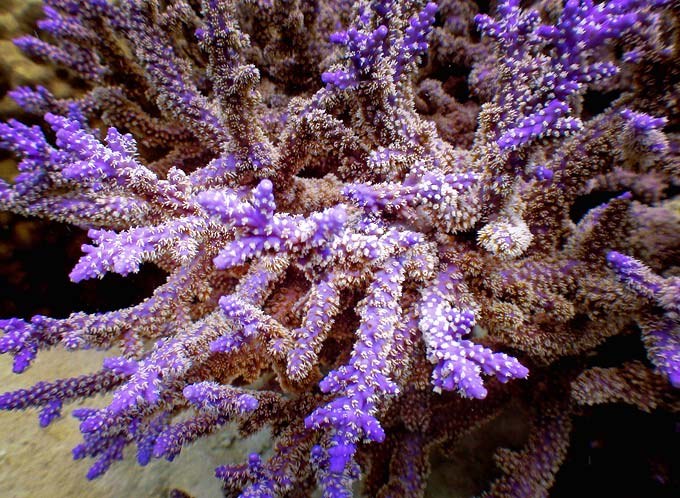
Can we train corals like this magnificent Acropora horrida to handle higher temperatures? Photo by Gareth
Background
According to current theories, three variables explain why some corals are more tolerant to higher temperatures than others:
- Genetic basis
- Type of Symbiodinium (zooxanthellae symbiont) a coral harbors
- Environmental acclimatization/adaptation
The HFLD study
Past research has mostly focused on the first two variables. Earlier this year, researchers from Hopkins Marine Station (at Stanford University) took advantage of the diverse back-reef lagoon pools of the American Samoa to conduct an experiment to focus on the latter two variables.
In the American Samoa, some pools exhibit thermally variable temperature swings (temp range 25.0–35C), while others exhibited more thermally moderate diurnal variation (26.5–33.3C). The researchers collected fragments of Acropora hyacinthus (a popular tabling SPS for reefkeepers) from these pools and “compared mortality and photosystem II photochemical efficiency of colony fragments [when] exposed to ambient temperatures (median:28.0C/82.4F) or elevated temperatures (median: 31.5C/88.7F).”
The study found that corals collected from the variable pools showed low mortalities when held at elevated temperatures, statistically indistinguishable from controls held at ambient temperatures. Corals from the variable pools all hosted the heat-resistant clade of Symbiodinium. On the other hand, corals from the moderate pools had a 50% mortality rate at the elevated temperatures, regardless of whether they hosted heat-sensitive or heat-resistant symbionts.

Graph of mortality rates at elevated temperatures. Note: Sym. D are heat-resistant zooxanthallae. Sym. C2 are heat-sensitive.
Corals from moderate pools with heat-sensitive symbionts showed rapid rates of decline in algal photosystem II photochemical efficiency. Corals from moderate pools and heat-resistant symbionts showed intermediate decline, while corals from variable pools with heat-resistant symbionts showed the lowest levels of decline. In other words, corals with heat-resistant zooxanthallae from either pools were better at dealing with heat stress, but those from the variable pool handled high temperatures the best.
The Cliff Notes: Corals with heat-resistant zooxanthellae that experience high frequency, low duration (HFLD) heating are significantly more resistant to prolonged high temperatures.
The study states:
Examination of gene expression after HFLD events has provided key insights into the mechanisms by which model systems acclimatize to their environment (Walton and Pringle 1980; Feder 1996; Ketola et al. 2004). In other systems, repeated exposure to brief heat pulses may induce constitutive changes that improve tolerance to prolonged temperature stresses, including changes in gene expression of small molecular weight heat shock proteins, membrane fluidity modifiers, and global transcriptional modifiers (Heath et al. 1993; Podrabsky and Somero 2004).
The researchers did not conclude how much of a role genes vs. environmental acclimatization play, but the study shows that corals exposed to high frequency, low duration heat stresses are “hardened” to prolonged heat stress. This acclimatization mechanism suggests corals may cope with rising ocean temperatures better than previously thought.

The 8000L Coral Farm of Machado de Sousa.
A Practical Reefkeeping Application?
Corals are able to shift symbionts in the wild – a process called adaptive bleaching. Science is currently unclear whether corals innately harbor different clades of Symbiodinium (switching between dominant symbiont types depending on environment) or whether they adopt new strains of zooxanthallae from the water column. If the former scenario is true or if we are able to culture heat-resistant Symbiodinium strains and introduce them to the water column, it may be possible to “train” corals to cope with prolonged higher temperatures via exposure to controlled HFLD heating. Coral farms, for example, can propagate hardier, heat-resistant corals, all the while reducing energy costs related to cooling and consequently resulting in greater profitability: a textbook win-win scenario for farmer and collector.
Hobbyists with mixed reef display aquariums are cautioned against experimenting with HFLD heating on their systems. Your corals may not harbor heat-resistant/tolerant zooxanthellae. If corals adopt new strains of zooxanthallae from the water column, it is unlikely they will do so in captivity because the water column in closed systems are devoid of diversity. Also, your tank’s other inhabitants (fish, crustaceans, echinoderms, gastropods, etc.) will suffer from the high frequency dynamic temperature shifts.
But the prospects of fostering heat-resistant corals are exciting!
References
Oliver, T.A. and Palumbi, S.R. 2011. Do fluctuating temperature environments elevate coral thermal tolerance? Coral Reefs 30: 429-440. Link to the full PDF of the study
Buddemeier RW & Fautin DG, Coral bleaching as an adaptive mechanism, Bioscience, 1993, pp 320–326(43)
Baker AC et al., Coral’s adaptive response to climate change, shifting to new algal symbionts may safeguard devastated reefs from extinction, Nature, 2004, pp 741(430)









0 Comments